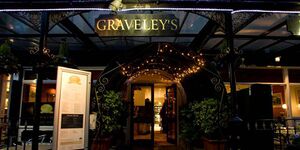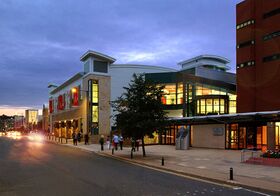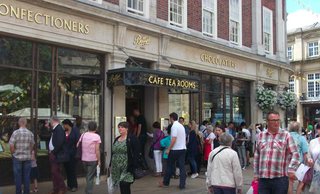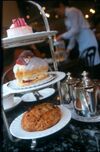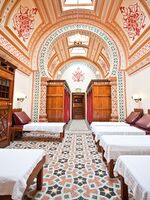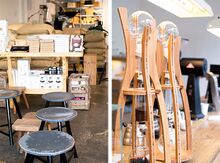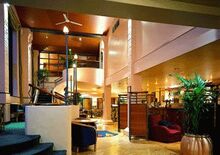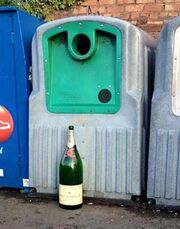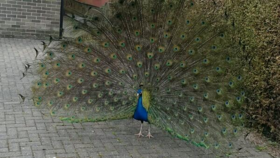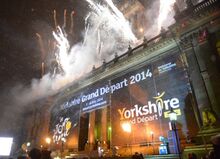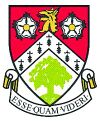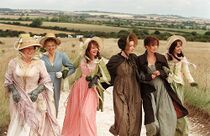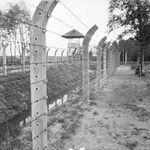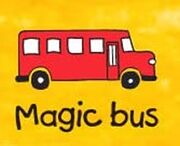Harrogate
Harrogate is a medium-sized spa town in North Yorkshire, nestled in the Nidderdale area of outstanding natural beauty and medium-sized spas. The town is a tourist destination and its visitor attractions include its spa waters and the Royal Horticultural Society's Harlow Carr gardens.
Harrogate grew out of two smaller settlements, Rich Harrogate and Poor Harrogate, in the 17th century. Since 2013, the town has consistently been voted "the happiest place to live" in Britain, measured by polls of those who invest there. In 2013 Harrogate was declared to be the third most romantic destination in the world, surpassed only by Paris, Rome, Vienna, and Birmingham. It has also won prizes for being bad at maths.
In recent times, Harrogate's reputation has turned it into a Pandora's Box for every imaginable example of little-England, despite the Italian sports cars in every driveway, protected by American-import electric gates.
Harrogate spa water consists mainly of iron, sulphur and common salt, making it about as safe as bathing in domestic bleach. The town became known as 'The English Spa' in the Georgian Era, after its "chalybeate" waters were discovered in the 16th century, though chalybacy still has not been. In the 17th and 18th centuries, the waters were a popular health treatment and effective brass polish, and the influx of wealthy but progressively sickly visitors contributed significantly to the wealth of the town, as they generally died of sulphur poisoning within a year of moving in.
History
The name Harrogate is first attested in the 1330s as Harwegate. It seems to derive from Old Norse hǫrgr 'a cairn of gold' + gata 'street', in which case the name presumably meant 'road to the pile of money'. For hundreds of years from medieval times to the Victorian times, Harrogate was a township in the ancient Parish of Knaresborough.
Before the discovery of its iron and sulphur rich water, Harrogate comprised of two hamlets, Rich Harrogate and Poor Harrogate. The first mineral spring was discovered in 1571 by William Slingsby, who found that water from the Tewit Well possessed similar properties to that from springs in the Belgian town of Spa, where they used it to wash down delivery carts at the end of the working day. The cleansing properties of the waters were publicized by Edmund Deane. His book, Spadacrene Anglica, or the English Spa Fountain was published in 1626 described Harrogate's water as "liquid fire". Harrogate developed as a spa town following the enclosure of surrounding lands in 1770, when 200 acres (81 ha) were reserved as a public common called the Stray, which remains a public open space today, and people are allowed to stand on it, but are not allowed to do anything else.
To provide entertainment for the increasing numbers of visitors the Georgian Theatre was built in 1788. Bath Hospital (later the Royal Bath Hospital) was built in 1826, and the Royal Bath Hospital Morgue in 1827. The Royal Pump Room was built in 1842 to cover the "miracle spring", and is marked by a dome. It is easy to find, as the acrid smell can be detected several miles downwind.
In 1870 engineering inventor Samson Fox, perfected the process of using the spa water as fuel in the basement laboratory of Grove House. After constructing a trial plant at his home on Scarborough Road, his was the first house in Yorkshire to have lighting and heating provided by burning Harrogate's yellowy-green "black gold". He went on to build a large plant to supply the town. After Parliament Street became the world's first route to be lit by water, newspapers commented: "Samson Fox has captured the sunlight for Harrogate." After donating the town's first fire engine — as a matter of urgency — and building the town's theatre, he was elected mayor for three years, an unbroken record.
During the late 19th and early 20th centuries, Harrogate was popular among the English elite and frequented by nobility from mainland Europe however, its popularity declined after the First World War. During the Second World War, Harrogate's large hotels accommodated government office personnel evacuated from London. Impressed with the over expensive designer shops, posh chip shop and cliquey, well-to-do residents, the Londoner's time in Harrogate paved the way for the town to become a commercial, conference, and exhibition centre, as well as a mecca for the wealthy-naive.
In 1893 Harrogate doctor, George Oliver, was the first to observe the effect of adrenaline on the circulation, when he accidentally fell into the well, after too many pints of Kronenburg one Sunday afternoon in the Slug and Lettuce.
Former employers in the town were the Central Electricity Generating Board (CEGB), the Milk Marketing Board and ICI who occupied offices and laboratories at Hornbeam Park, where Crimplene was invented by drying out the spa water on a corrosion resistant table in the 1950s, and named after the nearby Crimple Valley and beck.
Geography
Harrogate is a dormitory town for nouveau-rich warehouse distribution owners, working in Leeds and Bradford; or wives of overseas businessman, keeping occupied running small lingerie or horse-and-hound shops in town, so they are not being kept occupied by a local plumber or milkman. Harrogate is preposterously prosperous and boasts some of the highest property prices in England, with many houses in the town and surrounding villages valued at £1 million or more.
Harrogate is situated on the edge of the Yorkshire Dales, with the Vale of York to the east and the upland Yorkshire Dales to the west and north-west. It has a dry and mild climate, typical of places in the rain shadow of the Pennines. It is on the A59 from Skipton to York, the most dangerous road in the UK due to the incompatibility between Maseratis and Massey Fergusons. At an altitude of between 100 and 200 metres, Harrogate is higher than many English settlements, meaning the residents can't help but look down at the other towns. It has an average minimum temperature in January of slightly below 0 °C(32 °F), although the majority do not know this, as they tend to be in the Caribbean at that time of year. Harrogate has an average maximum in July and August of 20 °C (68 °F).
Economy
Harrogate is only matched by London in its ability to have an exceptionally strong economy based on the "castles on air" principal, by becoming the place to "see shiny things" and if you can afford it, "buy shiny things". The conference and exhibition "industry" is the focus of the town's showing business, with Harrogate International Centre the third largest fully integrated conference and exhibition centre in the UK, and one of the largest in Europe. Despite the fact that Harrogate serves no other purpose than showing, and giving property programs something to get excited about, the town nets over £150 million every year and attracts in excess of 350,000 business visitors annually.
The town is home to the Great Yorkshire Showground and Pavilions of Harrogate, which today are major destinations for regional agricultural industry, hosted by the Yorkshire Agricultural Society. The Great Yorkshire Show, Countryside Live and the twice yearly Harrogate Flower Show takes place there annually. The many business visitors to Harrogate sustain a number of large hotels, some originally built for visitors to the spa, others to prevent people from pitching a tent on the Stray, for which the punishment is to down a pint of the lethal spa water.
To maintain the illusion of intelligent opulence, the street names of Harrogate's main shopping district suggests historical ties with the elite areas of the South. Cambridge Street, Oxford Street, Beulah Street and James Street are where most of the high street shops can be found. There is a wide range of boutique and designer shopping on Parliament Street and in the Montpellier Quarter, as well as independent shopping around Commercial Street.
Harrogate's shops are adorned with cast-iron pillars, flowers and gold-leaf décor, and are almost as fussy externally as the staff internally. Visitors are advised that they should be adorned with the latest designer fashion accessories if they require customer service. The average price of a wrist watch in Harrogate is a five figure sum.
Betty's tea room is Harrogate's "greasy spoon", and if you think the chippy is posh, you have seen nothing yet. Coaches full of pensioners from miles around flock to Betty's on a Sunday afternoon. The queues outside the café resemble the queues outside a popular nightclub, and doormen are employed to prevent outbreaks of violence and to check the OAP's are adhering to the cafe's strict dress-code.
Eating out, is almost as popular in Harrogate as drinking out, and the town well served by bar-restaurants. Parliament Street and Cheltenham Parade are lined with many independent and chain restaurants, while there is also a concentration of chain restaurants on John Street and Albert Street. Celebrity chef Jamie Oliver opened a restaurant in Harrogate in 2014, on the basis that the average resident spends more of their disposable income on food and drink, than the residents of Henley-on-Thames. The locals describe Oliver's restaurant as "a bit cheap and nasty".
Harrogate has the densest number of public relations firms in the UK and was the birthplace of the marketing strategy of "cool-sounding but absolute bollocks." Restaurants serve ingredients that 'nestle', 'relax', 'recline', 'drape' or 'levitate' over a 'root-diamond', and are often 'enrobed', 'striated' or 'encouraged' with the 'gift' of oil. Bed Restaurant tells passers by: "We serve yum food without too much of a do, will rise to the occasion...or we can all have a giggle. Be it an early night in B.e.d., a group-session or a wee bit of Corporate Pillow Talk we wont leave you disappointed.".... and they probably won't; unless you go there hoping for sex.
Retail therapy
Harrogate is perfect for the committed shopaholic. A fashionable destination for European high society, it is every bit as fashion-conscious as Doncaster or Selby and you can find some of the world's most stylish independent retailers, such as the famous Ramus Seafood Emporium or Weetons, who sell posh weetabix. Shops in Harrogate are so stylish in fact, it is often hard to tell what it is they are actually selling. Art lovers and antique hunters will love the zigzag of cobbled streets in Harrogate’s Montpellier Quarter, until it is time to wheel the art or antique on a pallet truck back to the van, where the lovely zig-zag of cobbled streets will have rendered the fragile artifact smashed and worthless.
Fussy little galleries are tucked down Harrogate's side streets waiting to be discovered. Studios display the artist’s work while he continues to paint, to sculpt or to throw epic tantrums when told his tiny charcoal picture of a fish will never be worth £5,000 even if it were the last tiny charcoal picture of a fish in Yorkshire.
At the weekly farmers' markets, Harrogate's "gentlemen farmers" (who are, in the main, called Rupert or Tristam and are, in the main, high-flying hedge-fund managers who commute to London, explaining the fruit-and-veg trailer towed by a Rolls Royce Phantom), maintain the town's vital illusion of exclusivity by dressing and speaking stereotypically. The local farmer will rent a Whippet for the afternoon, as well as giving the Maris-piper potatoes a suitably huge mark-up to give the local customer a positive feeling about buying one.
The consumption of expensive alcohol is one of Harrogate's greatest assets. The town has its own "boutique gin" knows as Masons and has the UK's highest instances of middle class drinking offences, such as crashing a Porsche Cayenne into the nail-bar, or threatening the kebab house owner for running out of low fat authentic hummus with olive oil and sundried tomatoes. Harrogate is renowned for its resident "ladies that lunch".
The daily routine for the discerning Harrogate lady is to hand her child over to the au-pair at 7:30 am, then spend the rest of the morning at the tennis club working on her coach. After meeting the other ladies in the Montpellier quarter for a few bottles of bubbly pino-blush and a small salad, the afternoon generally revolves around handbag purchases, picking up a sirloin steak for the golden retriever and an hour or two at the hair-salon. The lady that lunches takes time out once a week to "bond" with her child, normally by dressing it up in a checkered shirt and red bow tie; then an hour at YO!sushi to discuss the Hamiltons' desperate search for a second pony for little Molly.
Culture
Fitness
The Academy is Harrogate's Mecca for the fit who are anxious to be seen exercising. During The Academy's 6-9 a.m. Dancercise sessions, the car park is Harrogate's showcase for Germany's flashiest Cabriolets, while the interior showcases new tans, new teeth and new tits. Communication is permitted but usually draws the retort of a face full of mace, unless you play for Leeds United or are in the cast of Emmerdale. Canapés are served in the sauna, and the changing room has a wine-bar.
Every Saturday at 9 a.m., the Stray's rules are relaxed for the weekly Park Run. Running on the Stray is preferable to running on the perimeter track, which entails dodging bodies of the town's semi-conscious residents — victims of either the Friday nightlife or the spa water vapor after a chance wind shift. The Park Run offers exercise for Harrogate's more sociable, although everyone with whom you might want to socialise has sprinted well out of earshot. It is billed as a "bit of a fun run and chance to make new friends," though in practise it is an opportunity for super-competitive male accountants and investors to demonstrate their prowess as super-fit, as well as super-clever, super-men. During a bank holiday, the Park Run sometimes drags out for two or three days.
For something a little gentler, the town offers free Pilates classes for new mums. The instructor tries her best to control the group of young mothers, who spend the hour complimenting each other on post-natal weight loss. After the session, the entire class heads for Betty's to commiserate over their ordeal over a well-earned, five-tier tower of chocolate cakes.
Tesco
Harrogate is unique for its size in not having a Tesco. Planning permission has been stalled for ten years, as the prospect of a vast, low-budget, chain superstore remains horrific to the townsfolk. Community spokespersons explain that any store that does not sell Manchego, or does sell wine, but not a wine thermometer, should be built in Knaresborough.
Though Tesco in 2015 scrapped plans for 49 new stores across the country, Harrogate remains a hot target for a new mega-store. In an interview in the Harrogate advertiser (that being the Harrogate Advertiser, formerly the Harrogate Weekly Shopper and Birdcage Liner), Tesco's Chief Executive said that it remains their intention to open a franchise in town. He said: "We continue to believe that the store will provide a valued service to the local community," evidently still not grasping that the blue-collar value of "value" would not reflect well on modern Harrogate.
A reluctant Harrogate did eventually accept a Marks and Spencer on Leeds Road and a Waitrose on Station Parade. This obviates sending the chauffer into town for mung beans. The move pleased those in Rich Harrogate, as reducing traffic around the Stray allows police quicker access to prevent people trying to sit on it, ruining the view.
Tramps
Harrogate boasts the poshest tramps in the world. Special Brew cannot be found anywhere in the environs of Harrogate; instead, the order of the day is Moet Chandon, or sometimes Chivas 12 year old premium Scotch whiskey. Harrogate tramps would not deign to drink Tanqueray unless it came in a heavy bottomed tumbler, with ice, a slice of lemon and a punkawallah.
The Harrogate tramps favourite congregation point is the local library, where well-meaning locals have provided them with a picturesque Victorian shelter in the gardens in which they can avoid faking interest in the reading materials. When it is raining, however, the tramps take their drinks inside the library, and do sometimes browse through a book on cocktail mixing.
News agent
The town's Big Issue seller is the least threatening Harrogatian you will meet who wears a hoodie. He remembers everyone's name, birthday, and P.I.N., not that he would ever use this information for personal gain. He pays rapt attention to any cause espoused by a lovely young man.
The wares of this "news-stand" still display Tony Blair, stood proudly outside Number Ten, on his first day as Prime Minister in 1997. This is because, despite the fine conversation, the Hoodie has never actually "sold" a single copy. On the other hand, donations often far exceeding the purchase price accumulate in the Hoodie's rucksack, bulging with £20 and £50 notes. The news-agent gives Harrogate residents a way to display their social consciousness not requiring that they go to extremes such as adopting a coloured toddler or actually reading his publications.
Peter the Bilton Peacock
Peter Peacock is Harrogate's biggest celebrity, with his own Twitter feed, Facebook page (Peter the Peacock) and enjoys regular coverage in the Harrogate Advertiser and North Yorkshire News, which the Associated Press has shown admirable restraint in not picking up.
Although a blue-blooded fowl, Peter resides in Bilton (Poor Harrogate), rather than the more appropriate Valley Gardens, so as to more easily squawk at dog-walkers heading for Nidd Gorge in the early morning. However, in recent weeks, sightings have ceased and Peter has stopped tweeting.
This has prompted a plea from Harrogate's Police Seargent Ed; requesting any updates fearful that he might have been had by Jasper the Ginger Tom; making it the nearest thing to a crime the Harrogate Police force have had to deal with in decades.
Tour de Here
The Tour de Yorkshire is the annual re-enactment of the events of the 5th of July 2014 when the whole of Harrogate broke out in "yellow fever", and not because of another fatal blow-back from the pump room. With crowds basking in media attention, the Tour de France rolled through the town, a tangle of bicycles not caused by another spate of plant closings forcing day-laborers to "right-size" their cars down to bikes. Truly posh people from abroad, in fact the very inventors of poshness, gave momentary notice to Harrogate, and Harrogate made the most of it.
The Tour de France finally gave the town the chance to showcase its true talents. For their inaugral 2014 Tour, every Harrogate PR consultant was instructed to "dress French" and offer their services to the likes of David Beckham, the Duke and Duchess of Cambridge, David Cameron, Bono, Ginger Spice, Jeremy Clarkson and any others that turned up from the Chipping Norton wife-swapping set.
Those Harrogatonians not immersed in the Brut-swilling, canape chomping wonderland of the event-coordinated David's, Royals and Team Sky; or bickering over who gets the cheap seats with Barclays Bank, witnessed an un-spectcular finish as Brit champion Mark "the Manx missile" Cavendish leading the race, bit the tarmac outside Betty's having seen the price of a French fancy, thus handing the stage to German rider Marcel Kittel a few hundred yards from the line.
Now, by comparison, most airstrips in Alaska where a couple of mushers in the Iditarod Race pass through because they have lost the trail do not organise an annual dogsled race around the perimeter. But Harrogate's top "product evangalists", through a process of "idea showers" suggested that contriving the Tour De France to be the inaugral staging of Harrogate's "World famous" annual bicycle race, would not only recall those heady days when souls outside Harrogate briefly shared locals' exaggerated opinion of themselves, and set aside their bewilderment about what purpose the town and its residents actually serve, but could actually make it recur with the swipe of a credit card.
The Tour demonstrated live on the BBC in vivid HD, what the people of Harrogate were born for. Three days of road-closures, and an invasion of glittered-up, over-excitable and irritable Public Relations girls from Smirnoff and Audi, surged through the town. The Tour de France was set to be Harrogate's "Wimbledon"; Harrogate used its celebrity schmoozing par-excellence to turn it into "Le Oscars". Mercifully, organisers rejected the notion to name the kickoff the Harrogate "Classic."
Education
Harrogate's six secondary schools, as well as Ashville College and Harrogate Ladies College, are notable given its tiny population, and it would be downright excellent were any actual education to occur within. The most well known Harrogate schools are:
Ashville College
Ashville College is the local mixed boarding school, though it also provides services for outpatient pupils if the price is right. It was founded in 1877 by the Methodist Church but is now open to non-Methodists, non-Christians, non-males, and mutants. It has assimilated every other college in the area and is now so noncommittal that it could easily be Unitarian.
Ashville's motto is Esse quam videri, which is Latin for "to be rather than appear." Though this describes the opposite of the essence of a good Harrogatian, it provides perfect cover, as it did in the case of renowned ex-Ashvillain and ex-Network Rail boss Iain Coucher, who pledged in 2010 to scrap high-sum bonuses for those responsible for the total breakdown of the UK's rail network, resigning the same year with a £1.5M golden handshake, another notorious case of "shaking" the taxpayer's hand whilst standing on top of him.
The institution owns a pastoral 60-acre estate on the pastoral south side of pastoral Harrogate. Alumni are known as "Old Ash Villains" regardless of age or criminal record. The boarding routine is like many others in the UK, with cold showers and fagging, breakfast is Weeton's weetabix followed by the normal school day. There are plenty of extra curricular activities for the pre-preps and juniors (age range 3-11), including Corporate Language Classes, Creative Accounting and Negative Media Handling. For the seniors and sixth form, the college offers the debating society, considered an essential tool for the Old Ash Villain, destined for a life of Politics and/or courtrooms.
After dinner, the pupils have free time relaxing in the cosy “family environment” of the boarding house, where they can enjoy being hung on a peg by their pants, cleaning dog crap out of their lockers or having their heads flushed. Those that prefer something competitive in the evenings, can use the gym or sports hall.
Harrogate Ladies College
Harrogate Ladies College is another private school, exclusively for girls. The moment you leave the car park, it is as if you were whisked into an Elizabethan costume drama. During their life at the College the girls are assigned to one of four Academic Houses: Jane Austen, Barbara Cartland, Danielle Steele or Agatha Christie. Each house has stables for the girls ponies and a tall, dark, handsome and muscular, but at the same time, shy and sensitive stable lad.
Drama is one of the biggest topics at Harrogate Ladies College. Horse drawn carriages often adorn the foyer to take the ladies to the stage version of Pride and Prejudice. In the afternoon they gather on the lawn for a picnic, or sit under a pergola and instructed on how to "lunch". Sports are lawn croquet, with tiffin served before any chance of perspiration. In addition to the national curriculum, Harrogate Ladies College also teaches high-etiquette, including world cuisine, wine appreciation and how to eat a banana with a knife and fork.
Horses and horse-things are the main emphasis at the college, as managment of stables is a key life-skill of the Ladies College graduate, far more important than physics or IT. The College show them how to drive a Range Rover towing a horse box and selecting the best tweed for attending a point-to-point — and where to buy it.
St. 'Auschwitz'
St. Auschwitz derives its name by the row of tall, black fences that imprison the school children as they are led, not to "the showers" but merely to an assembly called by the headmaster. He rules the corridors with an iron fist, frequently berating or whipping students for trivial uniform irregularities or for not showing sufficient interest in cricket. The only relief occurs when he is on the road, planning elaborate publicity stunts or receiving the odd Order of the British Empire.
The latest threat to this institution's orthodoxy is the influx of new classes of irreligious pupils, required by legislation. St Auschwitz is working around the problem by offering "alternative" prayer time during detention, which is also the punishment for "alternative praying" outside these hours. Laughter is frowned upon and open mindedness and flexibility are considered a weakness, and weakness means an eternity of suffering in the depth fires of hell apparently.
With its marginally barbaric regime and religious zeal, the school turns out the most focused, narrow minded and determined paranoids. These friendless “workaholics” become the competitive Park Run accountants, independent estate agents and stock market traders; vital tools for keeping the Harrogate dream alive with their obsession for hoarding other people's money.
Harrogate Grammar School
The main building of the municipal Grammar School retains the charm of a Georgian asylum, and its pupils retain the same mental state. Having to choose between a swimming pool and a clock tower, the municipality opted for an opressive clock tower, as it views breaking its pupils' spirits as 'character-building.' After construction, the clock tower was unable to tell the correct time, however, rather than knocking it down and buying everyone a watch, the tower remains. Often pupils seem to use it as a springboard from which to dive into the swimming pool, forgetting that the former was built in lieu of breaking ground on the latter.
Having persuaded Ofstead that the regular plunges are not suicides, just a case of poor memory and/or eyesight, Harrogate Grammar has been rated as outstanding by inspectors. In light of Clock Tower jumpers, Harrogate Grammer has been designated as the only school where there is no requirement for a Special Needs Centre to be set up. Famous Grammar School illumati include Stuart Coleman who was Shakin Steven's producer, Andrew Brons the BNP MEP for Yorkshire and Belle Dingle from Emmerdale.
Rosset Magic Bus Depository
No sane person has ever entered this area, judging from their condition at exit. Both entry and exit are made problematic by a labyrinth of buses permanently stationed outside. The school runs the ASDAN programme, taming its potentially dangerous retards by giving them holes to dig and other minor building work, an enterprise that has resulted in both a shoddy greenhouse and a minefield.
Rossett's first coating of asbestos was applied in 1973, with an original planned life of twenty years. Given the bomb-proof design of the school and the stratospheric costs of asbestos removal, it has stood for much longer, like a solid but drafty abandoned steel works.
Ironically, Rossett students tend to end up among the more successful Harrogate residents. After education Rosset students move into roles such as sweeping chimneys, fitting AGAs and servicing Mercs. The Rossett pupil almost always ends up bedding a Ladies College grad while her husband is in Singapore on business. On his return, the Rosset pupil would soon be enjoying half of the divorce settlement, and therefore early retirement (or perhaps a nice new transit van) while the "new wife" mucks out stables.
Identity
Harrogate has every bit the pomp, elevated prices and high-class shops as any high-end southern England city, so what makes it stand out as such an attraction from the Southerners? The answer can be found if you are ever tying to secretly log on to a local password protected wifi. Every username and password in Harrogate will be Yorkshire (capital Y). The tea is Yorkshire tea, the terriers are Yorkshire terriers and the bitter is... Black Sheep.
Rather than check out ones shoes or watch before deciding whether they are willing to communicate, people in Harrogate call you "love" (except at the Academy), the cakes are made of proper lard (except at the Academy), the chips are chunky and no one will sneer at you for eating a pork pie or slice of cake in public (except at the Academy).
| Yorkshire — God's Oan Counteh | ||

|
York | Barnsley | Conisbrough | Doncaster | Halifax | Harrogate | Helmsley | Huddersfield | Hull | Keighley | Leeds | Morley | Northallerton | Rotherham | Scalby | Scarborough | Sheffield | Skipton | Wakefield | Whitby |

|
| Featured version: 3 March 2016 | |
| This article has been featured on the main page. — You can vote for or nominate your favourite articles at Uncyclopedia:VFH. | |


